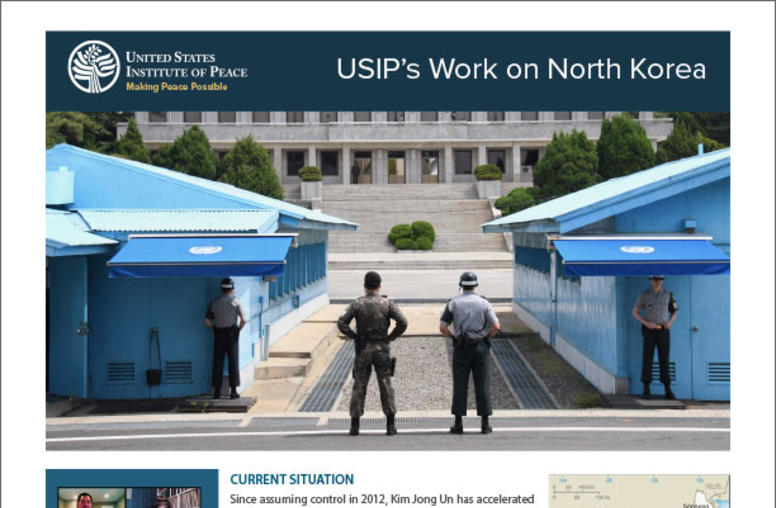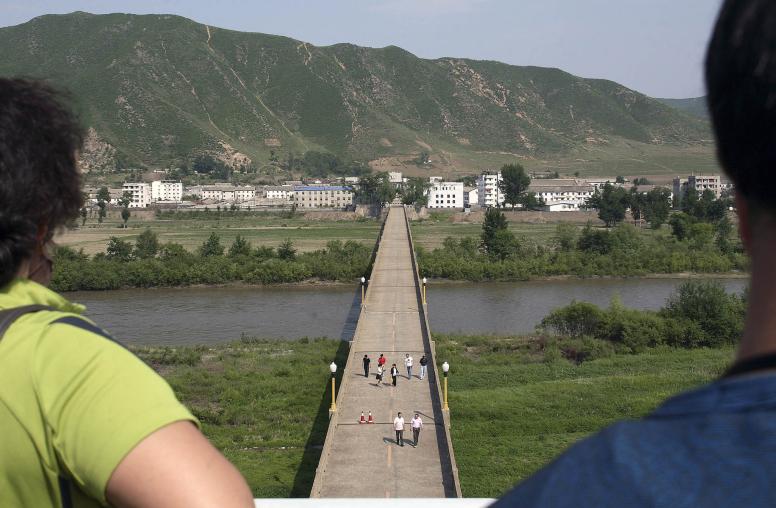Crises on the Korean Peninsula
The United States and North Korea are in a tense nuclear stand-off; U.S.-South Korean relations are straining under the weight of rising anti-Americanism south of the DMZ. What options are open to U.S. policymakers to resolve these crises?

During the past several weeks tensions on the Korean peninsula have dramatically risen. With the United States and North Korea in a nuclear stand-off and rising anti-Americanism straining South Korean-U.S. relations, policymakers in Washington are confronting challenges on two very different fronts. What options are open to U.S. policymakers to resolve these crises?
On January 13 the Institute hosted a Current Issues Briefing to examine the security and diplomatic challenges these crises pose for the United States. Moderated by Asia specialist and Institute research and studies director Paul Stares, the briefing featured Robert Einhorn, senior adviser with the Center for Strategic and International Studies; Marcus Noland, senior fellow at the Institute for International Economics; and William Drennan, deputy director of research and studies at the U.S. Institute of Peace.
Iraq and a Hard Place
Only a couple of weeks into 2003, the Bush administration faces serious proliferation issues both in Iraq and on the Korean Peninsula. Unfortunately, however, according to Korea expert Robert Einhorn, "The options that the Bush administration faces are not very good." In a brief overview of the main courses of action open to the Bush administration, Einhorn pointed out:
- Due to the catastrophic human and economic toll that would accompany a military conflict on the Korean peninsula, a military response is not a viable option for the United States.
- Active political and diplomatic engagement with the North Korean government likely would not address the core issues needed to resolve the current crisis and could reward the practice of "nuclear blackmail."
- Applying pressure is unlikely to succeed as it would put extreme pressure on the already strained U.S.-South Korean relationship, and both South Korea and China have little interest in placing further economic strain on the North.
However, in spite of its drawbacks, Einhorn suggested that of the above three options engagement holds the most promise for U.S. policymakers. To maximize the possibility of success, though, he recommended that the Bush administration employ six main principles in attempting any direct talks in the engagement track:
- Talks must not be made under duress. Both parties need to make good-faith efforts before proceeding to build a sense of trust (such as North Korea pledging not to start reprocessing uranium from the reopened plant, and the United States pledging not to strike the plant in Yongbyon).
- South Korea–U.S. solidarity—both short and long term—is essential to both nations' interests.
- The United States and its allies must be prepared to address North Korean concerns without "rewarding" North Korea's recent behavior.
- Engagement must be incremental with discussion of nuclear weapons development and proliferation first and other security, food, economic, and human rights issues later.
- Any new agreements must be based on a firm verification regime.
- The current crisis is not an issue of North Korea versus the United States and other regional powers (South Korea, China, Japan, and Russia) all have a role to play in any negotiations as well as the implementation of any agreements.
In closing, Einhorn stressed that ultimately engagement will not succeed if Pyongyang is determined to create and maintain a significant nuclear arsenal. However, he also felt that Pyongyang's intent on this issue is unclear and that North Korea's leaders may not have even reached a final conclusion on this matter themselves.
Solving the Nuclear Conundrum on the Korean Peninsula
Recapping the apparent results of the recent unofficial talks in New Mexico, economist Marcus Noland noted that the one of the keys to solving the current crisis is understanding what is driving Pyongyang's sudden push to bolster its nuclear capacity. While most theories have focused on one of three ideas—"they're just crazy," nuclear deterrence, and bargaining chips or "food for nukes"—Noland offered another possibility. As outlined in his 2000 book, Avoiding the Apocalypse, he suggested that the current crisis might represent the third prong in an overall effort for Pyongyang to strategically reposition itself within the international community and ensure North Korea's long-term viability as a state.
To accomplish this task, Noland argued that North Korea would have to take three steps: scale down its conventional forces; pursue economic reform and open new international revenue/trade streams; and create and maintain a viable cache of weapons of mass destruction for strategic deterrence. Citing various actions during the past two years—including Pyongyang's efforts to improve relations with both the South and Japan—Noland suggested that recent actions that have precipitated the current crisis fit nicely within this framework.
Noland warned that there was an increasing divergence of opinion between South Korea and the United States on the threat and intent of Pyongyang. While U.S. policymakers are focused on the development of weapons of mass destruction, their counterparts in South Korea are more concerned about the state of North Korea's economy and the possibility of troop demobilization on both sides of the Demilitarized Zone. Noland also cautioned that: "The Bush administration's apparent preferred alternative to seek the eventual collapse of North Korea through the process of isolation and containment is risky and ultimately not credible...[The] administration's apparent and excessive focus on one—albeit important—part of this puzzle is unlikely to resolve the entire North Korean nuclear conundrum."
The Test of Time: Challenges Ahead for the U.S.–South Korea Alliance
Wrapping up the day's presentations, Institute Korea security expert William Drennan stressed that in addition to the current tensions with Pyongyang the Bush administration was currently faced with perhaps the rockiest state of relations with South Korea in U.S. history. Expanding upon Noland's remarks, Drennan stressed that the threat posed by North Korea has dramatically evolved over the past thirty years in the minds of most South Koreans. Bolstered by a vibrant and growing middle class, a new generation of leaders throughout South Korea have come to view U.S. forces in South Korea less as a security shield than as an impediment to better North-South relations Drennan noted. This, he argued, pointing to an array of recent events, has led to the creation of an atmosphere of anti-Americanism that is unparalleled in the history of the American–South Korean alliance.
In looking ahead, Drennan cautioned that, while the American-South Korean alliance has weathered storms and other tensions before, the current anti-American sentiment and divergence of priorities between Seoul and Washington must not be treated lightly. The danger of unchecked hypernationalism (or a focus on national pride versus national interest) could result in a "push-pull effect" where South Koreans do not want U.S. troops and where the U.S. military does not feel welcome in South Korea. This, Drennan emphasized, would be a loss for both the United States and South Korea as both nations have benefited tremendously from their fifty-year alliance—an alliance that has served as a linchpin in securing overall stability and security in East Asia for years.
This USIPeace Briefing reflects the presentation and comments from "Crises on the Korean Peninsula"—a Current Issues Briefing held at the U.S. Institute of Peace January 13, 2003. The views summarized above reflect the discussion at the meeting; they do not represent formal positions taken by the Institute, which does not advocate specific policies.
The United States Institute of Peace is an independent, nonpartisan institution established and funded by Congress. Its goals are to help prevent and resolve violent international conflicts, promote post-conflict stability and development, and increase conflict management capacity, tools, and intellectual capital worldwide. The Institute does this by empowering others with knowledge, skills, and resources, as well as by directly engaging in peacebuilding efforts around the globe.



